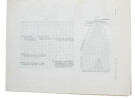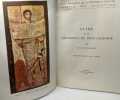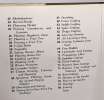281 books for « pearson r l pears... »Edit
-
Type
Book (280)
Music sheets (1)
-
Language
English (4)
French (275)
Latin (1)
Russian (1)
-
Century
17th (2)
18th (1)
19th (8)
20th (167)
21st (37)
-
Countries
Belgium (20)
Canada (2)
Côte d'Ivoire (1)
Denmark (18)
France (214)
Italy (1)
Switzerland (24)
United States of America (1)
-
Syndicate
ALAC (2)
CLAM (1)
CLAQ (1)
ILAB (130)
NVVA (1)
SLACES (1)
SLAM (106)
Topics
- Abraham (1)
- Agriculture (1)
- Anticipation (2)
- Archaeology (3)
- Architecture (2)
- Architecture/ urban planning/ memorials (1)
- Army (4)
- Astrophysics (1)
- Bibliography (5)
- Bibliothèques (1)
- Biography (2)
- Black africa (1)
- Brittany (1)
- Calvin jean (1)
- Children’s books (6)
- Civilisation (1)
- Collections (1)
- Comic strip (5)
- Curiosa (1)
- Dedication (1)
- Detective novels (6)
- Dressmaking (3)
- Ecology (3)
- Education (2)
- Education - morals (1)
- Embroidery (2)
- English (9)
- English literature (1)
- Entomology (5)
- Environment (1)
- Fashion (1)
- Fine arts (2)
- First edition (5)
- Gardens (2)
- Geography (1)
- Germanic languages (2)
- Greece (2)
- Hackney (3)
- Historical general points (1)
- History (4)
- Home economics (1)
- Isaac (1)
- Islam muslim (7)
- Latin (1)
- Literature (19)
- Mammals (1)
- Mathematics (9)
- Medicine (5)
- Military arts (1)
- Motor vehicle (1)
- Navigation (1)
- Navy (3)
- Nichol john (1)
- Ornithology (4)
- Orpheus (1)
- Palaeontology (1)
- Pathology (1)
- Pearson john (13)
- pharmacy (1)
- Physics (2)
- Policy (1)
- Psychiatry neurology (1)
- Psychoanalysis (2)
- Psychology (4)
- Quebec (1)
- Real-life (2)
- Religions (2)
- Ruth (1)
- Sciences (1)
- Scores (1)
- Social sciences (1)
- Songs (1)
- Sports (1)
- Spying (4)
- Tea (2)
- Teaching (1)
- Testimonies / stories (2)
- Theatre (1)
- Ussr (2)
- Various (4)
- Vegetable garden (2)
- Version (1)
- Waltz (1)
- War (5)
- Weaving (1)
- Youth (2)
The Vertebrate Brain.
1976 xi, 744 p., 215 figs, cloth (dust jacket). Ex libris, library stamps, number pasted on spine dust jacket.
Untersuchung uber die Geschichte der Kuhpocken : in besonderer Hinsicht auf die Ausrottung der Kinderpocken. - [EARLY WORK ON SMALLPOX]
Nürnberg, 1800. 8vo. In contemporary half calf with gilt lettering to spine. Small paper-label pasted on to top of spine. A fine copy. XII, 132 pp.
Rare first German translation of Pearson's work on smallpox translated by J. Fr. Küttlinger (originally published in 1798 under the following title: ""An Inquiry Concerning the History of the Cowpox, Principally with a View to Supersede and Extinguish the Smallpox""). Vaccination reached the European continent in 1800 and the present publication is one of the very earliest to describe this. Pearson was an early supporter of smallpox vaccination and endorsed Edward Jenner, promptly publishing his initial observations shortly after Jenner's Inquiry was released. In 1799, he played a key role in establishing the Original Vaccine Pock Institute in London, distributing vaccine samples. Unfortunately, some of these samples were contaminated with the smallpox virus, leading to a disagreement with Jenner, who felt overshadowed. As Jenner gained prominence, Pearson became envious. In 1802, when Jenner sought financial recognition from Parliament, Pearson presented a detailed account of his own contributions, challenging Jenner's sole credit for the discovery of vaccination. Pearson highlighted farmer Benjamin Jesty and others with prior claims. Despite Pearson bringing Jesty to London in 1805 to support his case during Jenner's second Parliamentary grant request, it proved unsuccessful. Not in Garrison & Morton
"PEARSON, KARL. - ESTABLISHING MODERN MATHEMATICAL STATISTICS AND BIOMETRICS.
Reference : 42461
(1894)
Contributions to the Mathematical Theory of Evolution. (I-) VI. (I. Contributions to...Received October 18, - Read November 18, 1893. - II. Skew Variation in Homogenous Material. Received December 19, 1894 - Read January 24, 1895. - III. Regression, H...
(London, Harrison and Sons, 1894, 1895, 1897, 1898, 1899 a. 1899. 4to. No wrappers as extracted from ""Philosophical Transactions"", Vol. 185 - Series A, pp. 71-110, textfigs. a. 5 plates. - Vol. 186 - Series A, pp. 343-414 a. 10 plates. - Vol. 187 - Series A, pp. 253-318 - Vol. 191 - Series A, pp. 229-311 - Vol. 192-Series A, pp. 169-244 a. 2 plates. - Vol. 192, Series A, pp. 257-330. All clean and fine.
First appearance of the founding papers of modern mathematical statistics, out of which grew Pearson's creation of Biometrics.""Founder of biometrics, Karl Pearson was one of the principal architects of the modern mathematical statistics. He was a polymath whose interests ranges from astronomy, mechanics, meteorology and physics, to biological sciences in particular, including...eugenics, evolotionary biology,heredity......Largly owing to his interests in evolutionary biology, Person created, almost single-handedly, the modern theory of statistics in his Biometric School at University College London.... In his creation of biometrics, out of which the discipline of mathematical statistics had develoiped by the end of the nineteenth century, Person introduced a new vernacular for statistics (including such termss as the standard deviation, mode, homoscedasticity, heteroscedasticity, kurtosis and the producct-moment correlation coefficient."" (Heyde in Statisticians of the Centuries).In the first paper offered here Person introduced the method of moments as a mean curve fitting assymetrical distributions (""point-binominals"") and he applies the theory to crabs and prawns. This is a general method for determining the values of the parameters of a frequency distribution.In the second paper offered here, Pearson develpoed the general formula to use for subsets of six types of frequency curves, now known as ""Pearson Type Curves"".In his seminal paper ""Regressin, Heredity and Panmixia"", the third papers offered here, Pearson introduced matrix algebra into statistical theory and also introducing 'eta' as a measure for curvilinear relationship, the standard error of an estimate, multiple regression and multiple and partial correlation, and devises the coefficient of variation as a measure of the ratio of a standard deviation to the corresponding mean expressed as a percentage.In the fourth paper he deals with the theory of probable erros and of correlations of errors...In the fifth paper he deals with the theory as involving multiple correlations...stature in biology is shown to be best reconstructed from measurements of long bones.The last paper offered deals with a variety of biological correlations, inheritance of characters etc. etc.G.M. Morant: A Bibliography ofthe Statistical and other writings of Karl Pearson Nos 2, 4, 6, 16, 17 and 20. - Eiasenhart in DSB, pp. 449-453.
[J.P. Migne] - Collectif ; Abraham Calov ; Johannes Piscator ; Jean Calvin ; Jacques Tirinus ; Saint Jérôme ; Willem Hessels Estius (Van Est) ; Ernst Friedrich Karl Rosenmuller ; Hugo Grotius ; Nicolas de Lyre ; Cornelius a Lapide ; François Watebled (Vatable) ; Augustin Calmet ; Sébastien Castalio ; Isidore Clario (Clarius) ; Jacques Cappel ; Lud. Cappellus ; Juan Maldonat ; Sébastien Munster ; Duclot ; Isaac Lemaistre de Sacy ; Gaspard Sanctius ; Jean-Etienne Menochius ; Juan de Mariana ; Johannes Drusius ; David Kimchi (Kimhi) ; Sébastien Castellion ; John Pearson ; Richard Pearson
Reference : 40790
(1841)
Scripturae sacrae, cursus completus. Tomus Decimus-Nonus (Tome XIX - 19 -) : In Jeremiam , in Baruch et in Ezechielem commentarium. Vatablus : In Jeremiam commentarium ; Joannes et Richardus Pearson : Critici sacri, sive Badvelli, Castellionis, Clarii, et Grotii commentaria in Baruch ; Maldonatus : In Ezechielem commentarium ; Hieronymus - Cornelius a Lapide - Bible de Vence, Praefationes, instructiones, epinicia et doxologiae ; Duclot - Rosenmüller - Calmet - Sacy - Synopsis - Anglicanae annotationes - cornelius a Lapide - Lyranus - Sanctius - Tirinus - Munsterus - Menochius - Mariana - Estius - Clarius - Maldonatus - Drusius - Castelio - Calovius - Piscator - Calvinus - Grotius : Variae annotationes
Ex. commentariis omnium perfectissimis ubique habitis, et a magna parte episcoporum necnon theologorum europe catholicae, universim ad hoc interrogatorum, designatis, unicè conflatus, plurimis annotantibus presbyteris ad docendo levitas pascendove populos altè positis. Annotavit vero simul et edidit J.P. Migne, 1 vol. in-4 reliure demi-basane bordeaux, Apud Editores, 1841, 1028 pp. Contient : Tome 19 : In Jeremiam , in Baruch et in Ezechielem commentarium. Vatablus : In Jeremiam commentarium ; Joannes et Richardus Pearson : Critici sacri, sive Badvelli, Castellionis, Clarii, et Grotii commentaria in Baruch ; Maldonatus : In Ezechielem commentarium ; Hieronymus - Cornelius a Lapide - Bible de Vence, Praefationes, instructiones, epinicia et doxologiae ; Duclot - Rosenmüller - Calmet - Sacy - Synopsis - Anglicanae annotationes - cornelius a Lapide - Lyranus - Sanctius - Tirinus - Munsterus - Menochius - Mariana - Estius - Clarius - Maldonatus - Drusius - Castelio - Calovius - Piscator - Calvinus - Grotius : Variae annotationes
Tome 19 seul. Agréable exemplaire de bibliothèque (anciens cachets d'institution religieuse et étiquette de cote en garde, bon exemplaire par ailleurs).
America Through the Eyes of Its People, Volume 2
PEARSON EDUCATION (US) (12/2005)
LIVRE A L’ETAT DE NEUF. EXPEDIE SOUS 3 JOURS OUVRES. NUMERO DE SUIVI COMMUNIQUE AVANT ENVOI, EMBALLAGE RENFORCE. EAN:9780321395764
"PEARSON, KARL. - INTRODUCING THE ""CHI-SQUARED GOODNESS-OF-FIT TEST""
Reference : 47148
(1900)
On the Criterion that a given System of Deviations from the Probable in the Case of a Correlated System of Variables is such that it can be reasonably supposed to have arisen from Random Sampling.
London, Taylor and Francis, 1900. Contemp. hcalf, spine gone and covers loose. In: ""The London, Edinburgh, and Dublin Philosophical Magazine and Journal of Science"", Vol. 50, Fifth Series. VI,(2),624 pp. a. 5 plates. (Entire volume offered). Pearson's paper: pp. 157-175. A stippled stamp on titlepage. Internally clean and fine.
In this fundamental paper in statistics, Pearson introduced his chi-squared test, the statistical procedure whose results are evaluated by reference to the chi-squared distribution, or the formula yielding a measure of how well a set of observations fits a theoretical hypothesis, the test of goodness of fit. A founding seminal paper in statistical testing theory.""Pearson’s many contributions to statistical theory and practice, many contributions to statistical theory and practice, this X2 text for goodness of fit is certainly one of his greatest"" and in its original and extended forms it has remained one of the most useful of all statistical tests."" (DSB).Parkinson ""Breakthroughs"" 1900 M.
Le Wagon plombé : Lénine année 17 - De l'exil au pouvoir
Belfond 1987 285 pages in8. 1987. Broché. 285 pages.
Etat correct légeres usures de la couverture et du dos intérieur bon
Après vous mon prince
Gallimard 1983 278 pages 18x11x2cm. 1983. Poche. 278 pages.
Bon Etat jauni
Guide de la synagogue de doura-europos / Haut-Commissariat de la République Française service des antiquités
Imprimerie Catholique Beyrouth 1940 in8. 1940. Broché.
couverture défraîchie ternie sous papier de soie intérieur propre
Les raids secrets des COPPs
France Empire 1972 in8. 1972. Broché.
Bon état couverture ternie bords frottés intérieur propre rousseurs sur tranche
Les raids secrets des COPPs
France-Empire 1972 in12. 1972. Broché.
Bon état général bords jaquette frottés tranche un peu ternie intérieur propre
N'en jetez plus
Presses de la cite / collection un mystere n° 327 1957 poche. 1957. Broché. Etat Correct
Je ne sais pas comment elle fait
France Loisirs 2004 415 pages in8. 2004. broché. 415 pages.
Bon Etat
Une femme d'argent
J'ai lu 1999 509 pages poche. 1999. Broché. 509 pages.
Très Bon Etat de conservation
Bernard shaw
Le pavois 1949 in12. 1949. Broché.
Etat Correct couverture défraîchie intérieur uniformément jauni propre
An Exposition of the Creed. The Third Edition, Revised and now more Enlarged. - [""THE VERY DUST OF HIS WRITINGS IS GOLD""]
London, Printed by J.F. for Job. Williams and are to be sold by Richard Davis, 1669. Folio (315 x 205). In contemporary full calf. Light wear to extremities, boards with scratches. Small paper label pasted on to top of spine. Small stain to title-page but internally generally fine and clean. (8), 398 pp.
Third expanded edition of Pearson’s highly influential ‘Exposition of the Creed. First published in 1659 it remained on the the most influential works on the Apostles’ Creed in the Anglican Church throughout the 17th century. Pearson dedicated his work to his parishioners of St. Clement's, Eastcheap, where he had previously preached the essence of the work several years earlier. Regarding the Christian cross, he explained in his commentary on the Apostles' Creed that the Greek term stauros initially meant ""a straight standing Stake, Pale, or Palisador,"" but when additional transverse or prominent parts were added to form a perfect Cross, it still retained its original name. He asserted that ""The Form then of the Cross on which our Saviour suffered was not a simple, but a compounded, Figure, according to the Custom of the Romans, by whose Procurator he was condemned to die. In which there was not only a straight and erected piece of Wood fixed in the Earth, but also a transverse Beam fastened unto that towards the top thereof.""
 Write to the booksellers
Write to the booksellers![Untersuchung uber die Geschichte der Kuhpocken : in besonderer Hinsicht auf die Ausrottung der Kinderpocken. - [EARLY WORK ON SMALLPOX]. "PEARSON, ...](https://static.livre-rare-book.com/pictures/LLX/60689_1_thumb.jpg)
![Untersuchung uber die Geschichte der Kuhpocken : in besonderer Hinsicht auf die Ausrottung der Kinderpocken. - [EARLY WORK ON SMALLPOX]. "PEARSON, ...](https://static.livre-rare-book.com/pictures/LLX/60689_2_thumb.jpg)
![Untersuchung uber die Geschichte der Kuhpocken : in besonderer Hinsicht auf die Ausrottung der Kinderpocken. - [EARLY WORK ON SMALLPOX]. "PEARSON, ...](https://static.livre-rare-book.com/pictures/LLX/60689_3_thumb.jpg)





























![An Exposition of the Creed. The Third Edition, Revised and now more Enlarged. - [""THE VERY DUST OF HIS WRITINGS IS GOLD""]. "PEARSON, JOHN.](https://static.livre-rare-book.com/pictures/LLX/60779_1_thumb.jpg)
![An Exposition of the Creed. The Third Edition, Revised and now more Enlarged. - [""THE VERY DUST OF HIS WRITINGS IS GOLD""]. "PEARSON, JOHN.](https://static.livre-rare-book.com/pictures/LLX/60779_2_thumb.jpg)
![An Exposition of the Creed. The Third Edition, Revised and now more Enlarged. - [""THE VERY DUST OF HIS WRITINGS IS GOLD""]. "PEARSON, JOHN.](https://static.livre-rare-book.com/pictures/LLX/60779_3_thumb.jpg)

